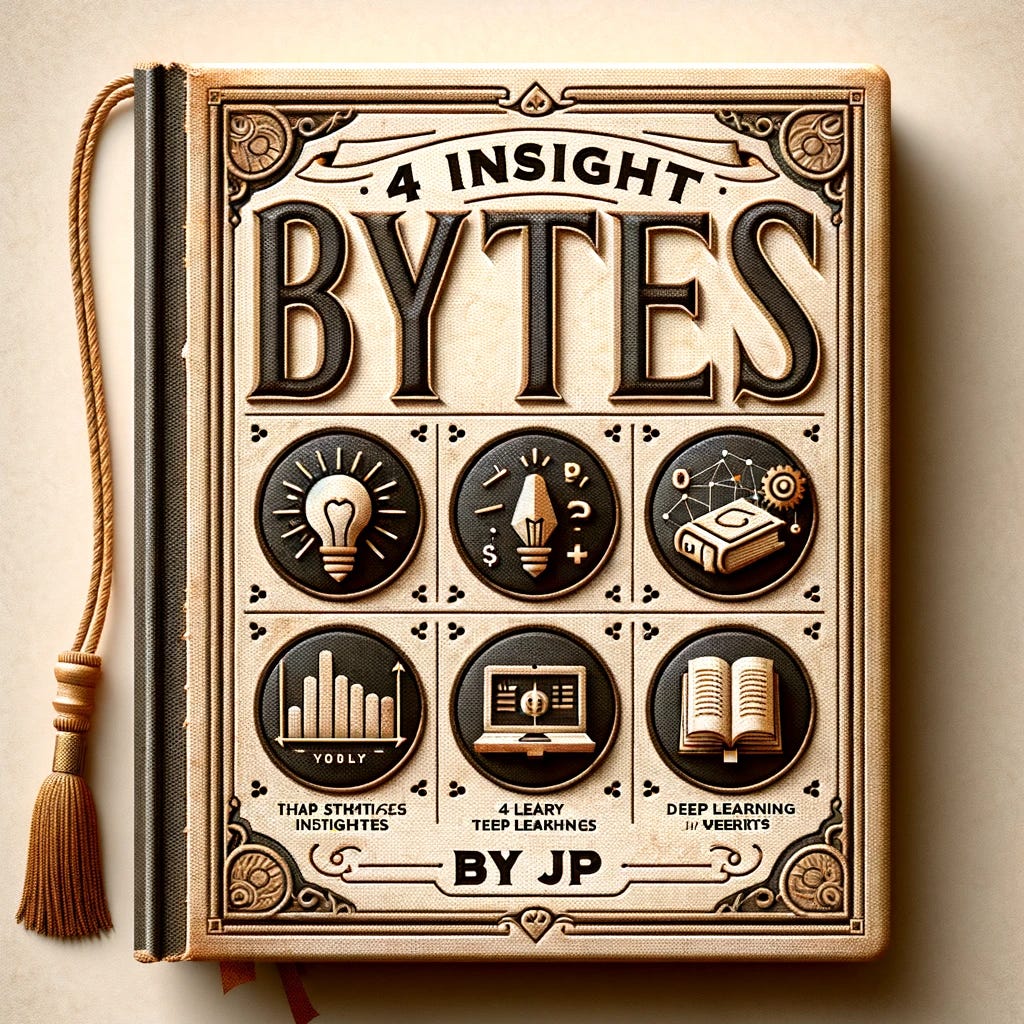4 Insight Bytes
Week 45, 2023
#1: Career Choices: The portfolio approach to maximizing job satisfaction and success.
Viewing your career as a portfolio of roles and opportunities helps you maximize your career success and satisfaction while taking into account life circumstances.
Why it matters:
Almost every decision has a downside. Looking at your next job as an opportunity and assessing how it fits into your overall career portfolio will help you quantify and manage potential risks.
Diving deeper:
Timing: Seizing opportunities requires taking risks. If you are just out of school or your kids are grown, this is not the time to play it safe (think: portfolio approach).
Industry: If you are young and want to make a difference, go into an industry that is experiencing a lot of growth and change. For older industries, make sure you are on the right side of radical change that threatens the existing industry order.
Location: Move to the city that is the center of your industry. Young, high-growth companies are a great environment with smart people, high expectations, and fast promotions.
#2: Connect to succeed: The art of impactful networking.
We have an implicit understanding that investing time and energy in building relationships with the right people will pay off. But most of us are still going about it the wrong way.
Why it matters:
Having the best information at the time of need requires excellent collaboration, extensive networking, and communication. Creating win-win's has become a necessity in our world.
Diving deeper:
Most people do not want to exercise their goodwill with important people. But relationships are like muscles: The more you work them, the stronger they become.
You must become as willing to ask for help as you are willing to give it to build a connected network.
It is better to give before receiving. Ask “how can I help you” more often than “how can you help me.” Sometimes, a simple introduction goes a long way.
Stop keeping score. When your interactions are driven by generosity, your rewards will follow suit. So keep contributing to your growing community of friends.
#3: Crafting clarity: The framework that improves your strategic storytelling.
Creating a messaging framework for your early-stage startup as your source of truth ensures consistency and scalability in your marketing approach.
Why it matters:
Messaging is the foundation of your go-to-market strategy and most of your sales and marketing assets (i.e., homepage, sales deck, emails, demo).
Diving deeper:
You ensure message-market fit by thinking intentionally about your positioning and ideal customer profile.
In your framework outline (1) the market, (2) your ideal customer profile, (3) competitive alternatives, (4) your product, and (5) your value proposition.
Steps for Competitive Alternatives: List the different alternatives. Cluster them. Add the limitations for each cluster. This allows you to build “competition battlecards” for each single competitor.
#4: The role of hedged dynamic tariffs in the energy transition.
Dynamic electricity tariffs with price hedging are the superior alternative when evaluated against criteria for flexible incentives, situational energy savings, and cost certainty.
Why it matters:
The energy transition requires a shift to dynamic electricity tariffs to cope with increasing annual consumption and peak loads caused by the integration of renewables and the electrification of industry.
Diving deeper:
Current electricity tariffs are not sufficient to provide the necessary incentives in a changing electricity grid. Yet, incentives are required to make electricity consumption more flexible.
While dynamic tariffs are often praised as the solution, they come with clear disadvantages. During the energy crisis, wholesale prices increased tenfold within months, leading to energy poverty and market interventions across Europe.
Dynamic tariffs with price hedging specify an annual volume (kWh), an hourly consumption profile, and a price (cents per kWh) over the contract term (one or more years). If households consume as much electricity as agreed, they pay exactly the contractually agreed price – regardless of price movements on the spot market.
The agreed volumes are fully insured against price spikes, while the incentive to save and shift load is always determined by the spot price. If the actual consumption deviates from the agreed volume, the hourly excess or shortfall will be invoiced or reimbursed at spot prices.
What was your favorite insight? Feel free to provide feedback or share with a friend.
Credits & Inspiration:
#1:
Marc Andreessen
#2:
Keith Ferrazzi - Never eat alone
#3:
Alexander Estner
#4:
Lion Hirth


